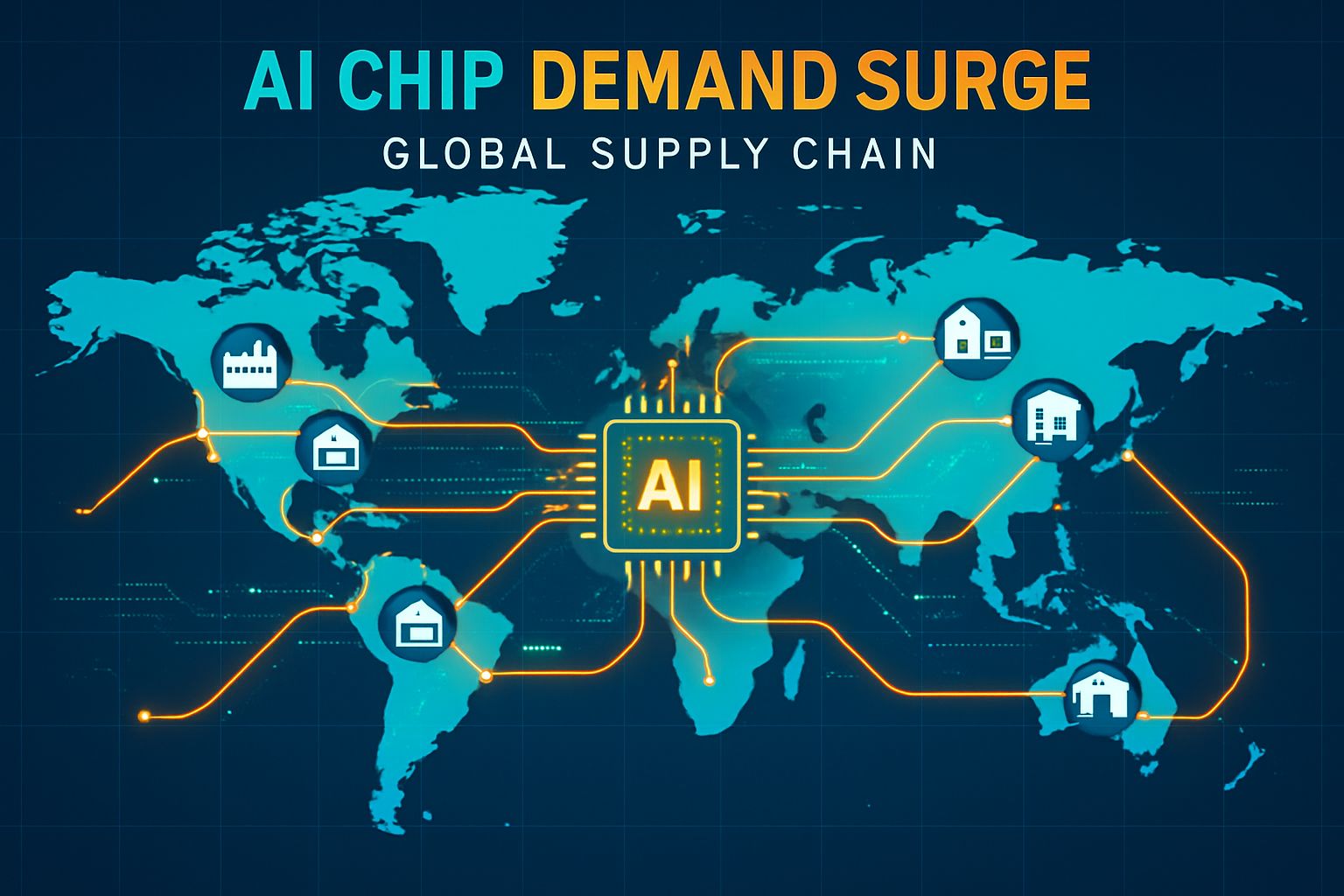
AI CERTs
13 hours ago
AI Chip Demand Surge Shapes Record Nvidia Blackwell Orders
Cloud providers are racing for silicon horsepower. Consequently, Nvidia’s March disclosures about Blackwell purchases sparked industrywide debate. The AI Chip Demand Surge now dominates boardroom agendas across infrastructure, finance, and policy circles. Moreover, hyperscalers see next-generation GPUs as critical for scaling complex language and agent models. Jensen Huang’s confirmation of 3.6 million units, excluding Meta, illustrated unprecedented appetite. Meanwhile, chip industry trends suggest demand still outpaces supply, despite aggressive fab expansion. Therefore, investors, engineers, and policymakers must understand the forces behind this scramble.
Hyperscaler Orders Eclipse Expectations
Nvidia stunned analysts by revealing 3.6 million Blackwell GPUs ordered by Amazon, Microsoft, Google, and Oracle. Furthermore, Huang clarified the figure understates true demand because Meta alone targets 1.3 million units. In contrast, prior flagship ramps never crossed one million units within launch quarters. The AI Chip Demand Surge therefore dwarfs earlier cycles. Colette Kress added that Blackwell delivered $11 billion in a single quarter, marking Nvidia’s fastest ramp. Additionally, Morgan Stanley research indicates a 12-month backlog, confirming limited near-term availability.

These volumes highlight two broader realities. First, hyperscalers prioritise AI compute demand over other capital projects. Second, they expect user growth in inference workloads that justify massive outlays. However, concentrated purchasing can amplify risk if one buyer slows spending.
This section underscores extraordinary booking levels. Nevertheless, supply limitations threaten delivery schedules, leading naturally to the next discussion on bottlenecks.
Advanced Packaging Capacity Crunch
Blackwell relies on TSMC’s CoWoS-L packaging and HBM3e memory stacks. Consequently, TrendForce projects over 150 percent growth in required CoWoS panels during 2025. Moreover, TSMC already runs lines around the clock, yet new modules take months to qualify. Therefore, packaging, not wafer output, caps shipments. Industry executives say every extra panel is pre-sold for a year.
Meanwhile, U.S. onshoring initiatives add capacity in Arizona. Nevertheless, those fabs will not reach meaningful yields before late 2026, offering little short-term relief. The ongoing AI Chip Demand Surge magnifies the crunch because each rack needs many high-end packages. Additionally, OEM partners such as Dell and Supermicro face lead-times exceeding 52 weeks.
- TrendForce: >150 % CoWoS growth forecast.
- Morgan Stanley: 12-month Blackwell backlog.
- TSMC Arizona: Production ramp expected 2026.
Packaging forms the narrowest supply funnel today. Consequently, stakeholders must weigh alternative accelerators or risk deployment delays.
These challenges highlight critical gaps. However, export controls introduce additional complexity, as the next section explains.
Geopolitical Export Control Constraints
Regulators continue scrutinising advanced GPU shipments to China. Consequently, Huang confirmed Blackwell exports remain on hold pending approvals. Moreover, secondary markets attempt to reroute supply, inflating prices above analyst estimates near $40 k per GPU. In contrast, domestic U.S. buyers face fewer hurdles, accelerating regional capacity build-outs.
Therefore, geopolitical policies directly influence chip industry trends and deployment geography. Additionally, hyperscalers hedge by designing custom ASICs to reduce dependence on constrained imports. Nevertheless, most training clusters still revolve around CUDA ecosystems, reinforcing Nvidia’s leverage during the AI Chip Demand Surge.
Regulatory friction slows certain orders. Subsequently, competitive responses become crucial, setting the stage for the next exploration of rivals.
Competitive Landscape Heats Up
AMD’s MI300 accelerators and Intel’s Gaudi roadmap offer alternative compute. Furthermore, cloud operators experiment with in-house silicon, including Google TPU generations and Microsoft-OpenAI collaborations. However, software maturity and ecosystem tooling still favour Nvidia for rapid deployment. Consequently, many customers split workloads, reserving Blackwell for frontier models while relegating smaller tasks to other chips.
Market analysts note that AI compute demand grows faster than efficiency gains. Moreover, even if AMD captures share, total accelerator volume will rise. Therefore, suppliers can all expand revenue simultaneously. In contrast, longer term custom ASIC success could erode Nvidia’s pricing power.
This section outlines evolving competition. Nevertheless, capital expenditure strategies provide the clearest signal of future momentum, as detailed next.
Strategic Capex Signals Strength
Meta plans up to $65 billion in AI infrastructure spending this year. Additionally, Amazon and Microsoft boosted guidance for data-center investments above prior highs. Consequently, hyperscalers allocate unprecedented budgets to support escalating AI compute demand. Blackwell racks feature better performance-per-watt, yet overall power draw still climbs because fleet sizes expand.
Moreover, faster chips reduce per-token costs, enabling new inference-heavy products. Therefore, finance chiefs justify spending by linking GPU fleets to revenue growth from generative services. In contrast, earlier capex waves focused on storage or networking gains, highlighting a shift toward compute dominance.
- Meta: 1.3 million GPU target.
- Azure: Multi-region “AI factory” builds.
- AWS: Proprietary Trainium coexistence with Blackwell.
Capital flows confirm sustained momentum. Subsequently, professionals must acquire relevant skills to manage and secure these sprawling clusters.
Skills And Certification Pathways
Enterprise architects now seek proficiency in high-bandwidth memory tuning, distributed training, and network orchestration. Furthermore, security teams require updated threat models for accelerated fabrics. Professionals can enhance their expertise with the AI + Network Certification. Additionally, managers value credentials that demonstrate cross-domain fluency from silicon to service.
Therefore, talent pipelines may become the next bottleneck after hardware. Moreover, certified staff help organisations optimise fleets and contain energy costs during the AI Chip Demand Surge. In contrast, teams lacking specialised skills risk under-utilising expensive assets.
Capability development anchors long-term competitiveness. Consequently, concluding insights will tie together market, supply, and talent dimensions.
Conclusion And Outlook
Nvidia’s record orders signal a historic infrastructure cycle. Moreover, supply chain, geopolitical, and competitive pressures shape rollout timelines. The AI Chip Demand Surge, amplified by rising AI compute demand and observable chip industry trends, remains the defining force in 2025. Consequently, organisations must monitor packaging capacity cues, export policies, and rival silicon progress while investing in skilled personnel.
Professionals should act now. Therefore, explore in-depth resources and pursue the linked certification to stay ahead in the accelerating AI economy.



